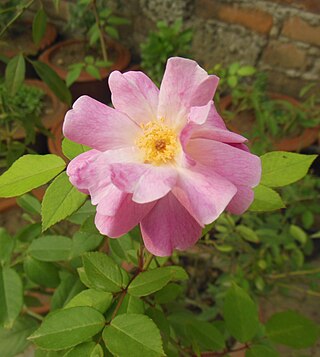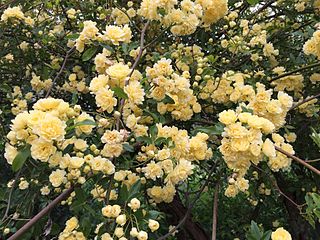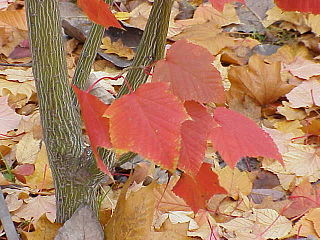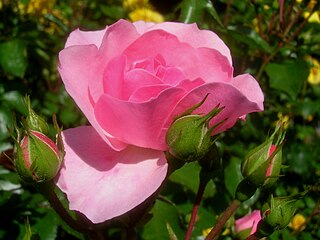
Buddleja is a genus comprising over 140 species of flowering plants endemic to Asia, Africa, and the Americas. The generic name bestowed by Linnaeus posthumously honoured the Reverend Adam Buddle (1662–1715), an English botanist and rector, at the suggestion of Dr. William Houstoun. Houstoun sent the first plants to become known to science as buddleja to England from the Caribbean about 15 years after Buddle's death.

Rosa rugosa is a species of rose native to eastern Asia, in northeastern China, Japan, Korea and southeastern Siberia, where it grows on beach coasts, often on sand dunes. It should not be confused with Rosa multiflora, which is also known as "Japanese rose". The Latin word "rugosa" means "wrinkled", referring to the wrinkled leaves.

Rosa multiflora — is a species of rose known commonly as multiflora rose, baby rose, Japanese rose, many-flowered rose, seven-sisters rose, Eijitsu rose and rambler rose. It is native to eastern Asia, in China, Japan, and Korea. It should not be confused with Rosa rugosa, which is also known as "Japanese rose", or with polyantha roses which are garden cultivars derived from hybrids of R. multiflora. It was introduced to North America, where it is regarded as an invasive species.

Hibiscus rosa-sinensis, known colloquially as Chinese hibiscus, China rose, Hawaiian hibiscus, rose mallow and shoeblack plant, is a species of tropical hibiscus, a flowering plant in the Hibisceae tribe of the family Malvaceae. It is widely cultivated as an ornamental plant in the tropics and subtropics, but its native range is Vanuatu.

Rosa glauca, the red-leaved rose or redleaf rose, is a species of rose native to the mountains of central and southern Europe, from the Spanish Pyrenees east to Bulgaria, and north to Germany and Poland. It is also found as an introduced species as far north as Scandinavia and Finland.

Rosa rubiginosa is a species of rose native to Europe and western Asia.

Rosa 'Anne Harkness' is an apricot floribunda rose cultivar developed by Jack Harkness in 1979 and introduced into Great Britain in 1980. The rose makes an outstanding cut flower and its exceptionally long lasting in water.

Rosa banksiae, common names Lady Banks' rose, or just Banks' rose, is a species of flowering plant in the rose family, native to central and western China, in the provinces of Gansu, Guizhou, Henan, Hubei, Jiangsu, Sichuan and Yunnan, at altitudes of 500–2,200 m (1,640–7,218 ft). The rose is named for Dorothea Lady Banks, the wife of the botanist Sir Joseph Banks.

Rosa chinensis, known commonly as the China rose, Chinese rose, or Bengal rose, is a member of the genus Rosa native to Southwest China in Guizhou, Hubei, and Sichuan Provinces. The first publication of Rosa chinensis was in 1768 by Nikolaus Joseph von Jacquin in Observationum Botanicarum, 3, p. 7 & plate 55.

Acer capillipes, is a maple in the same taxonomic section as other snakebark maples such as A. pensylvanicum, A. davidii and A. rufinerve. It is native to mountainous regions in Japan, on central and southern Honshū, Kyūshū and Shikoku islands, usually growing alongside mountain streams.

Acer davidii, or Père David's maple, is a species of maple in the snakebark maple group. It is native to China, from Jiangsu south to Fujian and Guangdong, and west to southeastern Gansu and Yunnan.

Rosa 'Cupcake', is a miniature rose, bred by Mark Spies in 1981. The cultivar was the winner of an American Rose Society Award of Excellence in 1983.

Rosa'Double Delight',, is a multiple award-winning, red blend hybrid tea rose cultivar bred in the United States by Swim & Ellis and introduced in 1977. Its parents were two hybrid tea cultivars, the red and yellow 'Granada' and the ivory 'Garden Party'.

Rosa 'English Miss' is a Floribunda rose bred by Roger Pawsey of Cants of Colchester, Essex in 1977. The cultivar was introduced into Great Britain in 1979. The plant is a compact, bushy shrub with light pink camellia-like flowers. It is disease resistant and blooms continuously from June to mid-October.

Rosa 'Nevada' is a white climbing rose cultivar developed by Pedro Dot in Spain in 1927. It is one of his most successful creations and is named for its colour, as nevada is the Spanish word for "snowy". Its parentage was long under discussion, as Dot introduced the cultivar as a hybrid moyesii, but the cultivar's round, black hips point to its R. pimpinellifolia-parentage. It is probably a cross between Dot's pink hybrid tea 'La Giralda' and the wild rose species Rosa pimpinellifolia var. altaica, but is sometimes still described as a hybrid moyesii.

Rosa blanda, commonly known as the smooth rose, meadow/wild rose, or prairie rose, is a species of rose native to North America. Among roses, it is closest to come to a "thornless" rose, with just a few thorns at the base. The meadow rose occurs as a colony-forming shrub growing to 1 m (3.3 ft) high, naturally in prairies and meadows. The roses are quite variable, the characteristics such as leaf tip number of prickles and glandular hairs usually do not always remain constant, thus it is often confused with Rosa arkansana or Rosa carolina, the two other prairie rose species.

Rosa 'Cécile Brünner', also known as 'Mlle Cécile Brünner', 'Sweetheart Rose', 'Malteser Rose', or 'Mignon', is a light pink polyantha rose bred in France by Marie Ducher and introduced by her son-in-law, Joseph Pernet-Ducher in 1881. Its parents were a double-flowered R. multiflora and a hybrid tea rose, either 'Souvenir d'un Ami' or a seedling of 'Mme de Tartas'. It is not clear if the rose was named after the sister (1853–1927) or daughter of Ulrich Brunner fils.

Rosa'Buff Beauty' is an apricot Hybrid musk rose cultivar, bred by Ann Bentall and introduced into Great Britain in 1939. Bentall and her husband, John Bentall, inherited the rose fields of acclaimed rose breeder, the Reverend Joseph Pemberton after his death in 1926. The rose was awarded the Royal Horticultural Society's Award of Garden Merit in 1993.

Rosa 'Bonica 82',, is a shrub rose cultivar, bred by Marie-Louise Meilland in France in 1982. The cultivar was named an All-America Rose Selections winner in 1987.

Rosa 'Soleil d'Or' is a Foetida hybrid rose cultivar, bred by Joseph Pernet-Ducher and introduced on November 1, 1900. It is the ancestor of all modern Hybrid tea roses and the first yellow-orange rose. Pernet-Ducher later crossed 'Soleil d'Or' with Tea roses to create a new class known as Pernetiana roses.





















